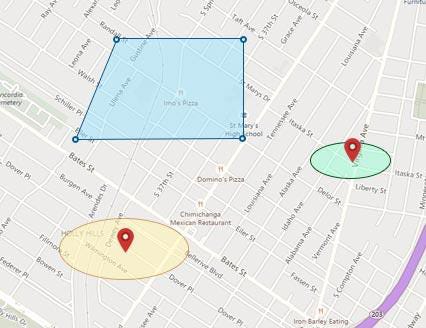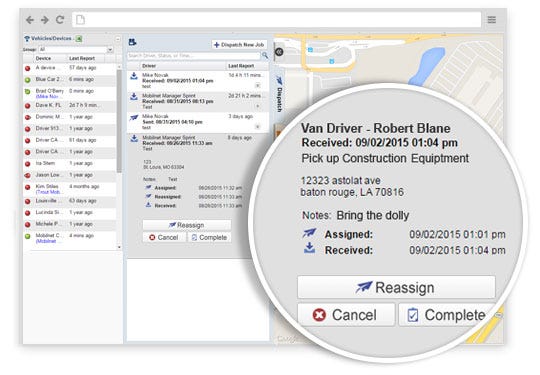Every industry has its own unique terminology, and the fleet industry is no exception. It’s important that fleet managers (and drivers!) keep up to date on industry jargon to stay at the top of their field. To help bulk up your vocabulary, we’ve compiled a list of fleet management terms you need to know.
1. IFTA - International Fuel Tax Agreement
Short for International Fuel Tax Agreement, IFTA is an agreement between the lower 48 states and Canada, excluding Alaska, Hawaii, and the Canadian territories. The agreement aims to simplify the reporting of fuel use for companies that operate in more than one jurisdiction. There are exemptions to the agreement“ for example, some states have exemptions for farm or government vehicles“ so make sure you do your research and know what rules apply to your fleet.
Linxup offers an IFTA add-on to simplify your fleet’s fuel tax management by automating reporting and allowing you to generate reports in seconds for individual vehicles or your entire fleet. You can also use our add-on to view fuel gallons used, find tax rates for individual states, and calculate the amount of fuel tax that is due.
Learn more about the Linxup IFTA add-on.
2. Geofence
 A geofence is an imaginary boundary, or virtual fence, drawn around a landmark or geographical area on a map that you would like to monitor. Geofences can be set to any size.
A geofence is an imaginary boundary, or virtual fence, drawn around a landmark or geographical area on a map that you would like to monitor. Geofences can be set to any size.
The most effective GPS tracking systems will enable you to receive email or text message notifications whenever your fleet vehicles enter or exit a geofenced area. This helps you ensure your drivers and vehicles are safe and secure by making it even easier to track unauthorized travel, after-hours use, or vehicle theft
Learn more about how geofencing can help you manage your fleet.
3. Landmark
A landmark is a virtual signpost that allows you to mark and quickly identify important locations like your head office, home, or jobsite on a virtual map. These special signposts can help you recognize where your drivers and vehicles are at a glance, making it easier to monitor your fleet and deliver better service.
4. Mobile workforce management (MWM)
 Mobile workforce management is a category of software and related services that are used to manage employees who work off the company premises, including mobile apps and PC software like Linxup’s GPS tracking system. MWM encapsulates all efforts to schedule, monitor, and track field teams in any industry.
Mobile workforce management is a category of software and related services that are used to manage employees who work off the company premises, including mobile apps and PC software like Linxup’s GPS tracking system. MWM encapsulates all efforts to schedule, monitor, and track field teams in any industry.
MWM includes features like our Route Monitor add-on, which allows fleet managers to adjust schedules and routes as needed. For example, if a driver finishes early, or if a driver is caught in traffic, fleet managers can quickly determine the easiest way to resolve the situation and ensure their customers receive prompt service. Whether that means rerouting the driver or sending someone nearby to finish the route or answer the service call, MWM is a key tool for improving your fleet’s productivity.
Ready to improve your fleet's productivity with GPS tracking? Request a custom quote here.
5. Moving violation
A moving violation occurs whenever a traffic law is broken while a vehicle is in motion, such as speeding, running a light, or drunk driving. In contrast, a non-moving violation“ which occurs when vehicles are not in motion“ includes things like failing to attend to faulty equipment properly or not observing lawful parking procedures.
Moving violations are broken down into major and minor violations:
- Major moving violations: Traffic crimes that can be prosecuted in criminal court. What’s considered major is state-dependent, but commonly includes DUI, DWI, and hit and run.
- Minor moving violations: There is no set definition for what constitutes a minor moving violation because the rules vary state by state, but generally minor violations don’t involve jail time. Minor violations commonly include: seat belt violations, disobeying traffic lights and signals, speeding, and improper or illegal turns.
Linxup GPS tracking devices can help your drivers avoid major and minor moving violations. With tools like driver safety report cards and real-time text message or email alerts for unsafe behaviors such as speeding or harsh braking, you can curb unsafe behaviors and ensure that your drivers operate their vehicles safely and efficiently.
6. Preventive maintenance
Preventive maintenance is defined as any maintenance performed on a piece of equipment to lessen the likelihood of it failing. This includes things like vehicle inspections, oil changes, and checking tire pressure.
It’s important for fleet managers and drivers to perform regular preventive maintenance because it keeps your fleet vehicles running longer, decreases the likelihood of unnecessary breakdown, reduces repair costs and time spent repairing your vehicles, increases productivity and driver safety, and can even reduce your insurance fees.
7. PTO - Power Take Off
PTO, or power take off, refers to any of several methods used for drawing power from a power source, such as running an engine. Essentially, PTO allows devices to draw energy from a vehicle’s engine, and is used to run an attached implement or machine such as a water pump, winch, or mechanical arm.
PTO systems are commonly found on tractors or trucks, and are comprised of a splined output shaft that allows the PTO shaft to be easily connected or disconnected, and a corresponding input shaft on the other end.
Read more about monitoring PTO using Linxup tracking devices.
Managing your fleet
Staying on top of industry jargon is important, but successfully managing an efficient and productive fleet requires more than just an understanding of fleet management terminology. Knowing how these terms apply to the practical management of your fleet can help you reduce costs and improve your fleet’s operations.
See what one customer has to say about using Linxup's Fleet Management system to help with employee accountability and location tracking.
Want to know more about the solutions discussed in this article? Reach out to us, click here on your phone or dial: 1-877-907-0801.



